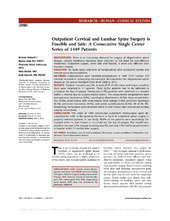| dc.contributor.author | Helseth, Øystein | en_US |
| dc.contributor.author | Lied, Bjarne Lidvar | en_US |
| dc.contributor.author | Halvorsen, Charlotte Marie | en_US |
| dc.contributor.author | Ekseth, Kåre | en_US |
| dc.contributor.author | Helseth, Eirik | en_US |
| dc.date.accessioned | 2016-03-10T13:36:49Z | |
| dc.date.available | 2016-03-10T13:36:49Z | |
| dc.date.issued | 2015-06 | |
| dc.Published | Neurosurgery 2015, 76(6):728-738 | eng |
| dc.identifier.issn | 0148-396X | |
| dc.identifier.uri | https://hdl.handle.net/1956/11602 | |
| dc.description.abstract | BACKGROUND: There is an increasing demand for surgery of degenerative spinal disease. Limited healthcare resources draw attention to the need for cost-effective treatments. Outpatient surgery, when safe and feasible, is more cost effective than inpatient surgery. OBJECTIVE: To study types and rates of complications after outpatient lumbar and cervical spine decompressions. METHODS: Complications were recorded prospectively in 1449 (1073 lumbar, 376 cervical) outpatients undergoing microsurgical decompression for degenerative spinal disease at the private Oslofjord Clinic from 2008 to 2013. RESULTS: Surgical mortality was 0%. A total of 51 (3.5%) minor and major complications were recorded in 51 patients. Three (0.2%) patients had to be admitted to a hospital the day of surgery. Twenty-two (1.5%) patients were admitted to a hospital within 3 months due to surgery-related events. The encountered complications were postoperative hematoma (0.6%), neurological deterioration (0.3%), deep wound infection (0.9%), dural lesions with cerebrospinal fluid leakage (1.0%), persistent dysphagia (0.1%), persistent hoarseness (0.1%), and severe pain/headache (0.4%). All of the life-threatening hematomas were detected within 6 and 3 hours after cervical and lumbar surgery, respectively. CONCLUSION: This series of 1449 consecutive outpatient microsurgical spine decompressions adds to the growing literature in favor of outpatient spinal surgery in properly selected patients. In our study, 99.8% of the patients were successfully discharged either to their homes or to a hotel on the day of surgery. The overall complication rate was 3.5%, surgical mortality was 0%, and only 1.5% had to be admitted to a hospital within 3 months after surgery. | en_US |
| dc.language.iso | eng | eng |
| dc.publisher | Wolters Kluwer | eng |
| dc.rights | Attribution CC BY-NC-ND | eng |
| dc.rights.uri | http://creativecommons.org/licenses/by-nc-nd/3.0/ | eng |
| dc.subject | Ambulatory care | eng |
| dc.subject | Cervical spondylosis | eng |
| dc.subject | Discectomy | eng |
| dc.subject | Lumbar spondylosis | eng |
| dc.subject | Postoperative complications | eng |
| dc.subject | Spinal degenerative diseases | eng |
| dc.title | Outpatient cervical and lumbar spine surgery is feasible and safe: A consecutive single center series of 1449 patients | en_US |
| dc.type | Peer reviewed | |
| dc.type | Journal article | |
| dc.date.updated | 2015-12-30T17:05:51Z | |
| dc.description.version | publishedVersion | en_US |
| dc.rights.holder | Copyright by the Congress of Neurological Surgeons | |
| dc.identifier.doi | https://doi.org/10.1227/neu.0000000000000746 | |
| dc.identifier.cristin | 1255273 | |
| dc.subject.nsi | VDP::Medisinske fag: 700::Klinisk medisinske fag: 750::Nevrokirurgi: 786 | |
| dc.subject.nsi | VDP::Midical sciences: 700::Clinical medical sciences: 750::Neurosurgery: 786 | |

